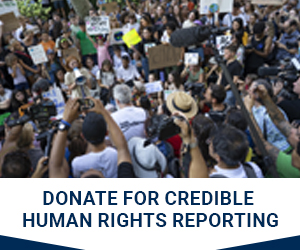China Eases Covid Restrictions in Response to the so-called ‘White Paper Revolution’

Theresa Erna Jürgenssen
East Asia Human Rights Researcher
Global Human Rights Defence
The biggest and most significant protest since the 1989 Tiananmen Square protests emerged all over China last week as a reaction to a fire that caused 10 people to die (Hsiao-hwa, 2022). The deaths could potentially have been prevented had there not been extreme Covid restrictions in place blocking the access to the burning building and locking people inside (Hsiao-hwa, 2022). In response, protesters gathered all over China, many holding up blank, white sheets of paper as a symbol of their opposition to anti-COVID restrictions as well as restrictions to free speech. The white paper symbolises everything the protestors want to say but cannot in the light of China’s strict stability maintenance system and has been suggested to also be a reference to election ballot papers, which are essentially meaningless in China (Hsiao-hwa, 2022). The protests have been termed the “white paper revolution” (Hsiao-hwa, 2022).
As a surprise to many, Chinese authorities have now started to ease several anti-COVID restrictions in response to the protests. The changes vary between regions but have generally included the reopening of restaurants, bars, supermarkets, hotels, cinemas, and gyms as well as the end of mandatory mass testing; public transport is also reopening and/or no longer requires a PCR test, people may at times even just isolate at home instead of a government-facility (McDonell, 2022). In order to prevent a future situation like the fire that started the protests, authorities announced that access to compounds under quarantine would no longer be blocked by gates and that passages must remain open for medical transportation, emergency escapes and rescues. (The Associated Press, 2022). While officially China is still following the zero-COVID policy, the way it is now easing restrictions suggests a new plan that “appears to be to slow the spread of the virus, […] enabling the health system to cope, rather than trying to crush the disease” (McDonell, 2022).
From a human rights standpoint the easing of measures should be welcomed. Under the banner of the zero-COVID policy China has taken many actions that were in contradiction with international human rights standards and potential violations of China’s human rights obligations. Most notably (and not exclusively) such rights included the right to the highest attainable standard of physical and mental health, the right to an adequate standard of living, the right to life, the right to liberty, and the right to freedom of movement. These rights are protected by the Universal Declaration of Human Rights, [1] the Convention on the Rights of Children [2], the International Covenant on Economic, Social and Cultural Rights [3], and the International Covenant on Civil and Political Rights [4]. While China’s zero-COVID policy has certainly managed to maintain a low number of cases, the World Health Organisation has called the policy “increasingly unsustainable” (The Associated Press, 2022). Moreover, the inhumane measures and interference with people’s rights simply cannot be viewed as proportional to what the policy has actually achieved.
Notes:
[1] The Universal Declaration of Human Rights is a universal but non-legally binding instrument and not a binding treaty. Many would, however, argue that it should be treated as international customary law. The rights mentioned are guaranteed by Articles 3, 9, 13, and 25.
[2] Ratified by China in 1992 (OHCHR). The rights potentially violated are guaranteed by Articles 6 and 24.
[3] Ratified by China in 2001 (OHCHR). The rights mentioned are guaranteed by Articles 11 and 12.
[4] China has not ratified the International Covenant on Civil and Political Rights. The rights would be protected by Articles 6, 9, and 11.
Sources and further reading:
Hsiao-hwa, H. (2022, November 30). Mute Protest: Chinese crowds hold up blank sheets to hit out at lockdowns, censorship. Radio Free Asia. Retrieved on December 05, 2022, from https://www.rfa.org/english/news/china/white-sheets-11302022143251.html.
Human Rights Watch. (2022, November 28). China: Respect Right to Peaceful Protest. Human Rights Watch. Retrieved on December 05, 2022, from https://www.hrw.org/news/2022/11/28/china-respect-right-peaceful-protest.
McDonell, S. (2022, November 05). China Covid: Xi’s face-saving exit from his signature policy. BBC. Retrieved on December 05, 2022, from https://www.bbc.com/news/world-asia-china-63857194.
The Associated Press. (2022, November 29). China lockdown protests pause as police flood city streets. The Asahi Simbun. Retrieved on December 05, 2022, from https://www.asahi.com/ajw/articles/14780176.
The Associated Press. (2022, November 30). China vows crackdown on ‘hostile forces’ as public tests Xi’. The Asahi Simbun. Retrieved on December 05, 2022, from https://www.asahi.com/ajw/articles/14781122.
The Associated Press. (2022, December 02). China security forces are well-prepared for quashing dissent. The Asahi Simbun. Retrieved on December 05, 2022, from https://www.asahi.com/ajw/articles/14783020.
The Associated Press. (2022, December 03). WHO pleased to see China ease harsh zero COVID policies. The Asahi Simbun. Retrieved on December 05, 2022, from https://www.asahi.com/ajw/articles/14783712.
The Associated Press. (2022, December 05). China eases controls, gives no sign when ‘zero COVID’ ends. The Asahi Simbun. Retrieved on December 05, 2022, from https://www.asahi.com/ajw/articles/14785063.
OHCHR. (n.d.). Ratification Status for China. Retrieved on November 15, 2022, from https://tbinternet.ohchr.org/_layouts/15/TreatyBodyExternal/Treaty.aspx?CountryID=36&Lang=EN.
Ting, G., Feng, G., Tung, C. (2022, December 02). China’s zero-COVID restrictions ease in some places, not in others: residents. Radio Free Asia. Retrieved on December 05, 2022, from https://www.rfa.org/english/news/china/covid-12022022141716.html.
Zifei, C., Yun, W., Tang, J. (2022, November 28). ANALYSIS: Chinese protests unlikely to grow into broader pro-democracy movement. Radio Free Asia. Retrieved on December 05, 2022, from https://www.rfa.org/english/news/china/china-protests-analysis-11282022135753.html.

































